Goliath is a term that describes something large or powerful, and we are talking about some goliath animals today. These animals are so large the term Goliath is just perfect for them. You are going to see some of the largest animals here, and some of them are unbelievably huge. Let’s take a look and see which one you find the most fascinating among the 5 of them below.
1Goliath Beetle
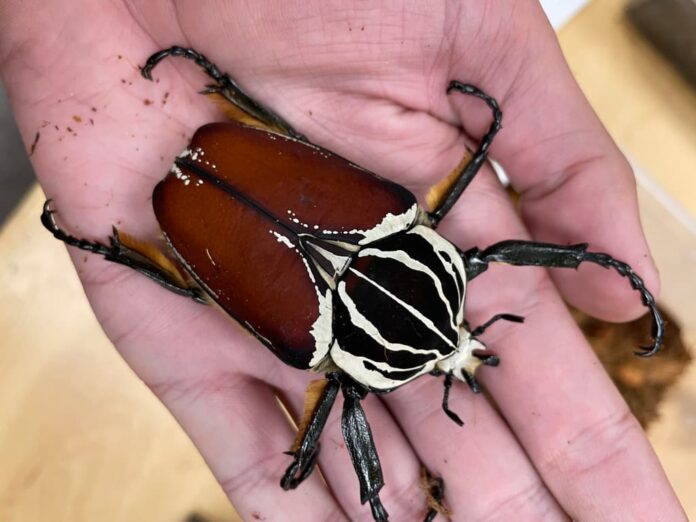
Goliath beetles refer to any of the 6 largest beetle species that are also among the largest insects in the world. You can easily recognize one by its (black and white) striped thorax with brightly colored abdomen. A goliath beetle has a bulky body composed of a thick chitinous exoskeleton that is very strong and protective. This exoskeleton protects both of it hind wings and their organs. Goliath beetles use their hind wings to fly, and they fold them completely between the elytra when not in use. At the same time, goliath beetles have sharp claws in each leg that give them a strong grip. That way, they are able to climb tree branches and trunks easily.
These large beetles like to be in Africa’s tropical forests where they can feed on fruit and tree sap. Goliath beetles are only found in Africa, especially in tropical forests as well as savannah and woodland habitats. Besides fruit and plant sap, goliath beetles also feed on animal matter and decaying plants. While having a short lifespan of only up to a year, Goliath beetles are an important part of the ecosystem. Both adult and larvae goliath beetles provide food for a large number of predators, maintaining a healthy food chain in the wild. Because of their interesting features, goliath beetles are also common as pets as well.
Fun Fact: Goliath beetles can lift over 800 times their own body weight.
2Goliath Birdeater
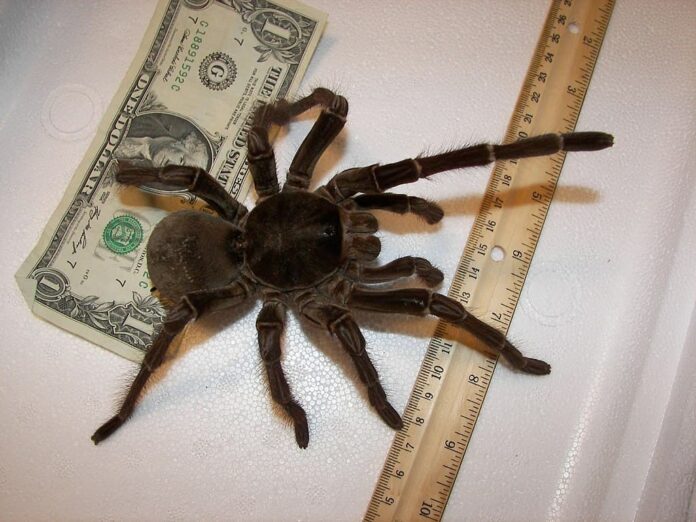
Introducing you to the largest spider in the world, the goliath birdeater. With a leg span of nearly a foot (30 centimeters), it is without a doubt that they are the largest arachnid on the planet. Coming across a spider the size of a dinner plate with fangs as long as your little toe is not something pleasant. It is true that this furry ball of a spider is slightly smaller than a huntsman, but it is twice heavier. This is why it is the largest spider in the world, by sheer mass. Or you can say that it is the largest tarantula in the world.
While having 8 eyes, their eyesight is not the best. Goliath spiders rely on the hairs on their abdomen and legs to sense vibrations from the air and ground. This allows them to know when prey is close as they hunt in the leaf litter on the rainforest floor.
The question is “Do they actually eat birds?”, they don’t usually but they are big enough to when they want to. However, their main diet consists of insects, frogs, and rodents on the land of the Amazon in Northern South America. These large spiders are common in rainforest trees, usually in deep burrows in the ground. When a goliath spider hunts a mouth, it uses its long fangs to bite and inject neurotoxins into the prey. Then it will drag the meal into its burrow and liquefy the prey’s inside to suck it dry because it can’t digest solid material.
Venom
Don’t worry if you actually come across one because their venom is not harmful to humans. Those large fangs can definitely cause some pain but that is pretty much it as the bite is more like a wasp sting. In fact, what you should worry about is the urticating bristles that they can release from their abdomen. This is another defense mechanism apart from the bite, and these barbed bristles are more dangerous than the bites. Because they are barbed, the bristles can lodge in the predator’s eyes, face, or mouth.
Fun Fact: A goliath birdeater can release a threatening hiss when alarmed by rubbing their hairs together. The hiss can be heard from several meters away, and it might come with a threat display.
3Goliath Grouper
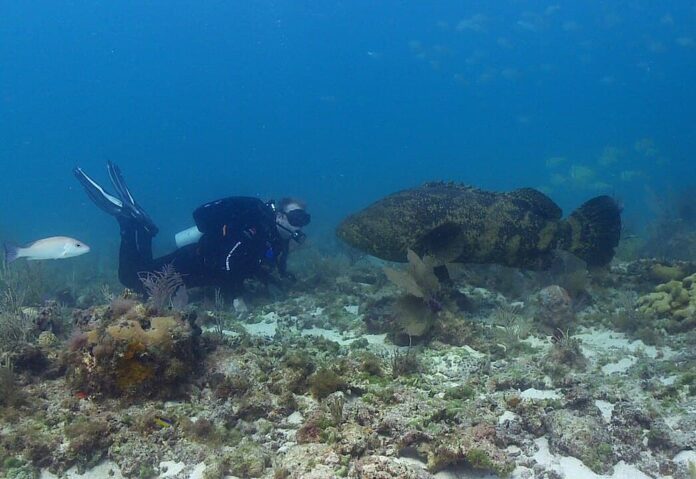
Grouper is a group of fish with a stout body and a large mouth, and the Atlantic goliath grouper is the largest of them all. An Atlantic goliath grouper can grow up to 2.5 meters long, with an elongated body with a broad flat head. The coloration of this fish species can range from brownish-yellow to grey and greenish, with black dots. An Atlantic goliath grouper’s lower jaw has 3 to 5 rows of teeth, with no front canines. Goliath groupers are docile, and they even approach divers and allow divers to pet them as well.
Also goes by the name jewfish, Atlantic goliath grouper is a saltwater fish that lives at depths from 1 to 100 meters. Adult jewfish are common in artificial reefs, oil platforms, rocky reefs, and wrecks as well as coral reefs. As for juveniles, they inhabit mangrove environments as well as in holes and under ledges of swift tidal creeks. Where they live, these ambush predators feed on their prey using a strong suction from their large mouths. Their common meals are crustaceans, fish, juvenile sea turtles, smaller sharks, and spiny lobsters. Goliath groupers are now critically endangered due to habitat loss and overfishing by humans.
Fun Fact: A goliath grouper has a huge gaping mouth that can swallow a human whole if the fish is large enough. The good news is that we are not their preferred meal so there is nothing to worry about.
4Goliath Frog
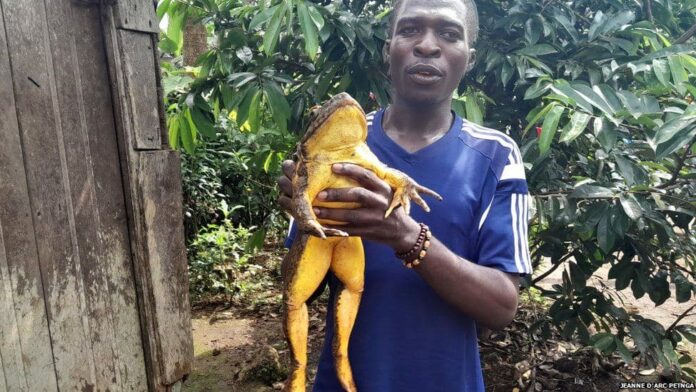
Here you are looking at the largest living frog in the world, the goliath frog aka giant slippery frog. A goliath frog can grow up to 32 centimeters from snout to vent, weighing up to 3 kilograms or heavier. Some goliath frogs can be so large that they are the size of a cat. It has a flattened body with a triangular head and husky limbs with fully webbed toes. These large frogs are omnivorous with a carnivorous preference so their food range is quite wide. Not to mention that they hunt both in water and on land, their prey could be aquatic, semi-aquatic, and terrestrial.
The goliath frogs are solitary and strong, and they can move heavy rocks that are over 4 pounds to create nests. Goliath frogs are more common in dense equatorial forest fringe, and they are also abundant in the cascades and rapids. As the habitat range is only in Cameroon and Equatorial Guinea, their population is declining due to habitat construction. Another factor that threatens their numbers is the collection and hunting for food and pet trade.
Fun Fact: Goliath frogs can leap almost 3 meters (10 feet) forward.
5Goliath Tigerfish
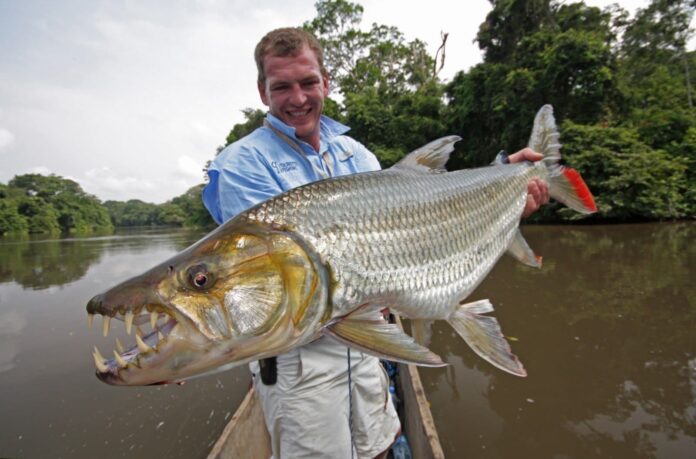
And last but not least, we have one of the largest and most dangerous freshwater fish in the world. This predatory fish can grow up to 1.5 meters long, weighing up to 50 kilograms while the heaviest specimen caught weighed 70 kilograms. Their scales are brown, gray, white, and yellow with a golden flush around their face. They also have an upright dorsal fin that gives a shark vibe, looking quite intimidating. The most noticeable feature of goliath tigerfish is they have daggers for teeth that grow up to 2.5 centimeters on average. A goliath tigerfish has keen sight and rapid speed that it uses to detect and hunt prey.
Being so large and powerful, these piscivores feed on any fish they can get their large teeth on. As a matter of fact, they are so fearsome their only known predator is the Nile crocodile. You know a fish species is fearsome when there are so many incidents of them attacking humans they have a reputation for it. Native to Africa, their distribution is around the lakes and rivers of the Congo River Basin. Their population is also quite abundant in Lake Tanganyika, Lake Upemba, and Lualaba River.
Fun Fact: Goliath tigerfish is the only African freshwater fish known to attack humans.
Related Post: Largest Marsupials You Should See



